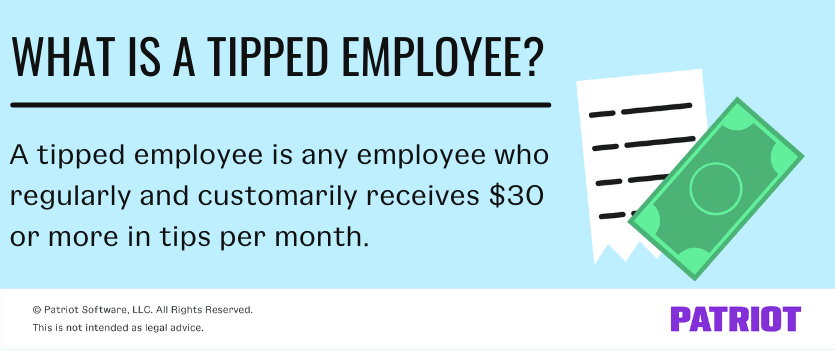As a business owner and employer, there may be times when your employees receive tips. But, does receiving a tip from a customer automatically make an employee a tipped employee? And if so, what are the laws, regulations, and requirements for tipped employees and their wages? Keep reading to learn more about how to handle a tipped employee.
What is a tipped employee?
According to the Department of Labor (DOL), a tipped employee is any employee who regularly and customarily receives more than $30 per month in tips. Common examples of tipped employees include:
- Casino employees
- Servers at restaurants
- Hairstylists
- Taxicab drivers
- Bartenders
- Baristas
- Nail technicians
- Entertainers (e.g., musicians)
- Delivery drivers
- Dog groomers
…And more. But, not all employees who receive tips are tipped employees. For example, a receptionist at a hotel may receive tips if they assist customers with bringing their bags to the room. However, this is not typical of the receptionist’s job, and the tips are infrequent. So, the receptionist is not a tipped employee.
Use Fact Sheet #15 from the DOL’s Wage and Hour Division (WHD) for more information about tipped employees.

What are tips?
Tips are extra, optional payments customers give employees at their discretion. Commonly, these payments are in the form of funds but can include other types of payments.
Types of tip payments to report to the IRS include:
- Cash tips directly from customers
- Electronic tip payments or settlements, such as credit, debit, or gift card payments or other electronic payment methods
- Tips from tip pools, tip splitting, or other tip-sharing arrangements
- The value of non-cash items (e.g., concert tickets or jewelry)
What is tip pooling?
A business might have tip pools if the business collects and redistributes a portion or all of the tip money employees receive. Basically, you collect some or all tips and put them into a large “pool” to divide among employees. Generally, only tipped employees do tip pooling.
Tip pooling is most common in the hospitality industry (e.g., restaurants). Once the business pools the tips, employers typically divide the funds according to the tip pooling policy.
Your policy may distribute the tips in at least one of the following ways:
- Number of hours worked
- Amount of customers served
- Evenly split among the employees
- A different way of your choosing
Check with your state for tip pooling laws. The DOL does not allow employers, managers, or supervisors to participate in tip pooling.
Employees may also voluntarily share their tips with other tipped or non-tipped employees in an informal manner, known as tip sharing. Whereas tip pooling is a formal process a business carries out, tip sharing is a process individual employees voluntarily carry out. Employee tip share occurrences are generally on a volunteer basis and are not overseen by the business itself.
Tipped minimum wage
Again, tips are payments from customers that are subject to tax withholding. Because tipped employees receive payments from customers, you might be able to pay them a special tipped minimum wage.
The federal tipped minimum wage is lower than the regular federal minimum wage of $7.25 per hour because of the tip credit (we’ll get to that in a minute). The Fair Labor Standards Act (FLSA) allows employers to pay tipped employees $2.13 per hour if the employer uses the tip credit. The lower wage is also known as the minimum cash wage.
States may have their own minimum wage for tipped employees and tip credits for employers. But, some states do not allow tip credits and require employers to pay at least the state minimum wage, even if the employee receives tips (e.g., Nevada). Check with your state to learn more about the tipped minimum wage by state.
Tip credit for employers
The FLSA allows employers to take a tip credit toward the federal minimum wage to pay eligible employees a lower wage than the standard minimum of $7.25.
Employers can take a tip credit because tip income ideally brings tipped employee wages back up to the federal minimum wage (or higher). Again, the federal minimum cash wage is $2.13. The standard minimum wage minus the minimum cash wage is the amount of the tip credit:
$7.25 – $2.13 = $5.12
The federal tip credit is $5.12.
States may have different tip credits or no tip credits. Check with your state for more information.
If employees do not earn enough in tips to reach the minimum wage, you must make up the difference. Maintain good records of how much time employees work and the amount of tips the employees receive.
Before you can use the tip credit, inform the employee of the following information:
- The cash wage you will pay the tipped employee
- The amount you will claim as a tip credit
- That the tip credit you claim cannot be more than the amount of tips the employee receives
- That the employee will retain all of their tips, except if there is a valid tip pooling arrangement in place
- The tip credit does not apply unless you inform the employee of the tip credit
You cannot use the tip credit if you do not notify the employee via an oral or written notice.
Beginning December 28, 2021, employers can only take a tip credit against an employee’s wages for the time a tipped employee performs tip-producing work. This includes work that produces tips and work that directly supports tip-producing work (if the work is not performed for a substantial amount of time).
| Looking for an easy way to pay your tipped employees? Patriot Software’s online payroll is a simple solution that allows you to add employees’ tips and calculate the withholdings. Try a self-guided demo today! |
Overtime for tipped employees
Nonexempt employees who work overtime are entitled to 1.5 times their hourly rate for each hour of overtime. Buf it a tipped employee works overtime, the calculation is a little bit different.
Tipped employee overtime requires a bit more math. Here are the steps for calculating overtime for tipped employees:
- Multiply the regular minimum wage by time-and-a-half (1.5)
- Subtract the tip credit from your total
- Multiply your total by the number of overtime hours
- Add the overtime wages to the regular wage total
Again, some states have a higher tipped minimum wage or do not have a tipped minimum wage. Use the higher minimum wage and tip credit to calculate overtime wages for tipped employees.
Withholding taxes on tips
Again, tip income is taxable income. So, how do you withhold taxes on tips as an employer?
After employees report their tipped wages to you, withhold federal income, Social Security, and Medicare taxes. And, employees may have to pay state and local income taxes on their tips, too.
As the employer, you must withhold taxes on all regular wages. And, withhold taxes on all tips over $20. Report tips on Form W-2, Box 7 (Social Security Tips). If tips for an employee are less than $20 for the entire month, the employee does not need to report the tips to the employer. Do not withhold taxes from an employee’s tips if the tips are less than $20 for that calendar month.
Employees must report all tips to you by the 10th day of the month after the employee received the tips. For example, employees must report tips earned in June by July 10. However, if the 10th day of the month falls on a weekend or legal holiday, the employee has until the next business day to report their tips.
Also, report all tips employees earn on both your quarterly and annual tax returns.
Check the IRS website for more information on reporting tip income.
This article has been updated from its original publication date of October 15, 2013.
This is not intended as legal advice; for more information, please click here.